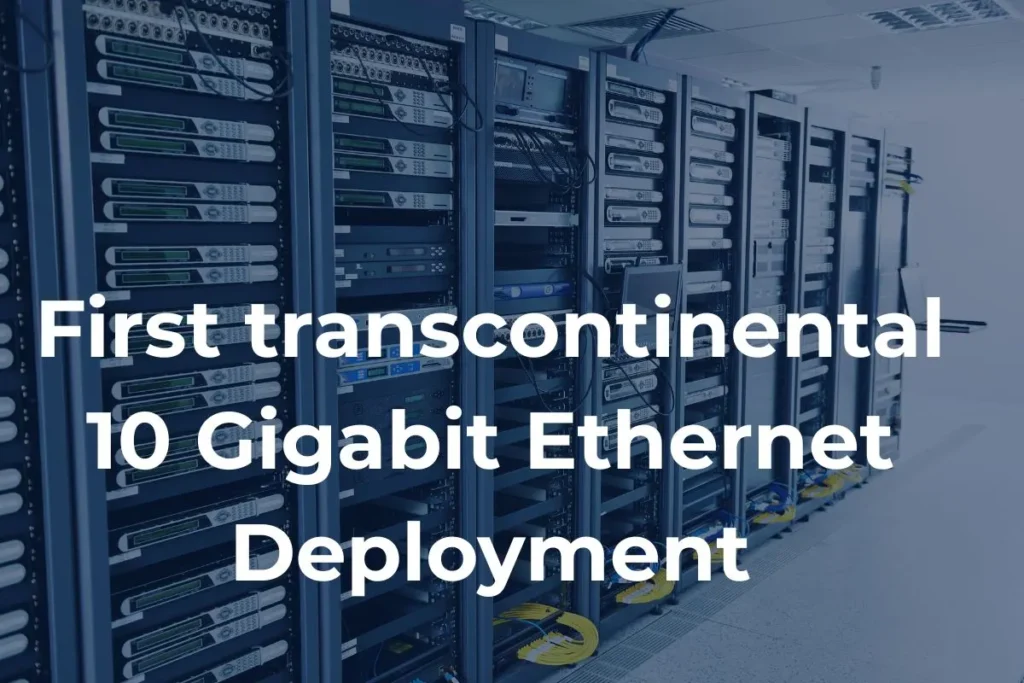The first 10 Gigabit Ethernet was designed for high speed data transfer in 2002. First transcontinental 10 Gigabit Ethernet (10 Gigabit Ethernet (10-GigE) connection was able to transfer the data across a continent at a very high speed of 10 billion bits per second (10 Gbps). This was a successful experiment at that time in a high speed networking field. The event took place in Scinet at the Supercomputing Conference (SC2002) in Baltimore, Maryland, USA. It covered Over 3,000 miles (~4,800 km) of data transfer from coast to coast in North America. More than one private industry and research organizations were involved in it. Here by this page you can learn more about the First transcontinental 10 Gigabit Ethernet Deployment that happened in 2002.
First transcontinental 10 Gigabit Ethernet Deployment
To connect various USA states with a very high speed internet of A 10-GigE the event was done. 10 Gigabit Ethernet proved that the data can also be transferred to long distances areas using this technology. Before LANs (Local Area Networks), technology was a popular technology that time that most of the industries were using for data transfer. LAN was also good but it was limited to the local areas only. 10-GigE came as an alternative to SONET/SDH technology. In major industries SONET/SDH technology was in use before the First transcontinental 10 Gigabit Ethernet Deployment. But both these technologies were costly and as well the structure of these technologies was also complex. Optical Fiber cables are used in this data transfer. On the other hand the 10 Gigabit Ethernet (10GbE) was not only cost efficient but also it has some features such Higher Bandwidth Efficiency, scalability.
Layered services (WaveNet, FrameNet, PacketNet)
Dark Fiber Infrastructure and Nationwide Backbone
What is 10 Gigabit Ethernet?
For the high speed data transfer across the various regions and continents the 10 Gigabit Ethernet technology was launched. Through this data can be transferred at 10 billion bits per second (10 Gbps) speed. The technology is used in data centers, high-performance computing, and large networks areas. The technology is faster and cost efficient with high reliability features. In the data transmission process signals of different wavelengths are multiplexed together on a single optical fiber cable. Later these signals are demultiplexed at receiver’s end. Dark Fibers are used so the data centres have their complete control and management of it.

History of First transcontinental 10 Gigabit Ethernet Deployment
Some private organizations and research agencies were involved in the First transcontinental 10 Gigabit Ethernet Deployment i.e. Level 3 communications, cisco system, star light, tera grid, and NCSA. This was a collaboration of various organizations where each organisation gave their contribution in the experiment. Before the experiment the ethernet was used in local area networks (LAN) only but the 10 Gigabit Ethernet Deployment experiment proved that it can also be used in WAN (Wide Area Networks) for long distance data transfers.Apart from this 10-GigE networks has various advantages too.
Benefits of 10 Gigabit Ethernet
There are multiple benefits of the 10 Gigabit Ethernet which we also have discussed here. You can see here 10-GigE advantages-
High Speed: It has a very high speed of 10gbps for data transferring. That makes it useful for high-bandwidth network areas such as data centers, cloud computing. It is also good for fast streaming as well.
Low Latency: it has very low latency for data transmission. It is ideal for gaming and other real time applications.
Cost Efficient: It is very cost efficient compared to other networks such as SONET where the hardware costing is very high.
Supports Multiple Media Type: It supports various media types like copper and fiber that gives flexibility in deployments.
Easy Network Design: It makes the design and infrastructure easier. Apart from these benefits there are some other advantages too.
Disadvantages of 10-GigE
After checking the advantages you must know some of its demerits too. Here are the few demerits of it-
Higher Power Consumption: The 10 Gigabit Ethernet consumes more power. That is the major disadvantage of it.
Optical Fiber Pricing: The pricing of optical fiber that is used for the data transfer is expensive.
Requirement of Cooling: It generates heat so it requires cooling equipment also.
Infrastructure: The infrastructure of it needs upgrade for switches, routers, and others.
Network Congestion: You may face network congestion if downstream is not able to handle the 10 Gbps.
All We Know
10GBase-LR and 10GBase-ER are good for long range data transfer. It is better than the SONET/SDH networks. Data is transferred at a very high speed of 10Gbps from one point to another. In today’s term it is good for advanced education, enables remote access to supercomputers, High-performance scientific computing, and real-time collaboration between labs.

Hello! I’m Kaylani , a professional content writer with a knack for breathing life into words. I have been providing high-quality, research-driven content in Sectors like Technology & Personal Finance . With a background in Finance Tech Management , I specialize in turning complex information into engaging content that resonates with a wide.
